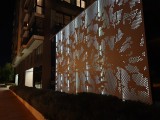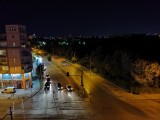Apple iPhone XS Max review

Dual 12MP camera with Smart HDR
The Apple iPhone XS phones have a similar dual-12MP (wide+telephoto) camera setup as the iPhone 7, 8 Plus, and X. The quad-LED dual-tone flash is here to stay, as well as the large piece of scratch-resistant sapphire glass that is supposed to keep everything away from harm's way.

The iPhone XS and XS Max introduce an all-new 12MP sensor for the main shooter with larger pixels - 1.4µm, up from 1.22µm and doubles the focus pixels. The telephoto camera has a 1.0µm pitch as before, no changes here.
The primary 12MP sensor sits behind a f/1.8 lens, while the telephoto one - behind a f/2.4 lens, both optically stabilized, just like on the iPhone X. The wide-angle f/1.8 lens has changed since the iPhone X, though. Now, the main camera of the iPhone XS and XS Max offers an equivalent field of view of a 26mm lens (in 35mm camera terms). The iPhone X had a bit narrower FoV with its 28mm lens.

The camera benefits from a new image signal processor with 4-frame buffer for zero shutter lag, and there is a new Smart HDR feature. In addition to those 4 frames, the camera also captures interframes, plus a long exposure, all of which are merged into a single photo with improved dynamic range.
Apple has finally gone the Pixel way, but as we established in our iPhone XS review - it's almost there but needs some fine tuning.
But wait, there is more. First, the iPhone doesn't need a second camera for depth sensing anymore, it does it only with the primary snapper and the power of the ISP's depth mapping and the data collected from the NPU.

The iPhone XS also offers an updated bokeh rendering, which Apple says it has lifted from the most expensive DSLRs. Alright... The XS also allows you to adjust the depth of field after a photo has been taken, while the iOS 12.1 update will allow you to do this in real-time from the viewfinder. You know, like Huawei does this for years.
The iPhone XS Max has the same 7MP f/2.2 selfie camera as on the iPhone X, but the sensor has improved in speed if not in resolution thanks to the new ISP. The front camera now can do 1080p videos at 60fps, and there is cinematic video stabilization available (always-on).
There is one final improvement in the iPhone XS Max camera - stereo recording for the video capture. Yes, finally! But it's not just regular stereo audio, it employs wider sound separation for richer sound and better listening experience. We listened to a couple of iPhone XS Max clips on a pair of expensive headphones and indeed, it's not just a regular stereo sound, it's rich in tones and quite surround-like and that's probably what Apple's calls wide stereo. We guess if you are going to do it super late, at least do it better than the others.
Unfortunately, the camera app hasn't been touched at all. It has the same interface that's been around for ages. And that's probably fine, but as usual, all image and video settings aren't in the camera app itself. Instead, you have to close the camera, open Settings, and then return to the camera. Hardly user-friendly!






Camera app and its separate settings
Image Quality
The daylight samples we took with the iPhone XS Max are flagship-grade as they come. There is plenty of resolved detail, the noise levels are kept low, and the dynamic range is way above average. Note that we are talking about the photos where the Smart HDR decided not to fire.
All 12MP images offer nice rendition, accurate colors, and are pretty sharp, sometimes even over-sharpened.










Apple iPhone XS Max 12MP camera samples
The Smart HDR stacks multiple frames with different exposure for better dynamic range and contrast, but there is also more detail captured in areas that previously looked like made of uniform colors (check the tiles). The foliage looks better in the HDR photos, and they have a more natural look as there is no over-sharpening.
Overall, we'd suggest leaving the Smart HDR option enabled - it won't hurt your photos, on the contrary, it can only improve them when necessary.




HDR off • HDR on • HDR off • HDR on
Here is an example where the Smart HDR brings more detail in some areas.
The telephoto camera on the iPhone XS Max is the same as on the X. It produces the same high-quality images as the wide-angle one and comes in handy when you need a bit of zoom. But while telephoto samples are equal in quality, the f/2.4 aperture makes them less susceptible to blown highlights, and the Smart HDR rarely decides to intervene.










Apple iPhone XS Max 12MP telephoto samples
The new sensor working with Smart HDR is supposed to offer big improvements in low-light. Naturally, the OIS allows the iPhone XS Max to drop the shutter speed to as low as 1/4s when shooting handheld. Now there are also bigger sensor pixels, and with some image stacking, the iPhone XS Max succeed in producing great low-light images with even exposure and free of noise.








Apple iPhone XS Max 12MP low-light samples
Unfortunately, the iPhone XS Max still won't use the OIS telephoto camera when shooting in low-light. The Max once again digitally zooms and crops the output of the main camera to achieve the zoomed effect. But as it turned out this isn't done only by Apple, Samsung does the same thing with the telephoto snappers on its Galaxy Note9 and S9+. Which is not an excuse.
This cropping and zooming, of course, takes its toll on image quality. Check those digitally zoomed photos below.




Apple iPhone XS Max 12MP low-light telephoto samples
You can trick the telephoto camera to shoot in low-light if you switch to portrait mode. The samples are more detailed, though darker because of the f/2.4 lens.




Apple iPhone XS Max 12MP native telephoto samples
You can put the Apple iPhone XS Max against other phones in our Picture Compare Tool. We've selected the iPhone 8 Plus and the Galaxy Note9, but you can change those as you please. You can check the telephoto camera quality with this tool as well.



Apple iPhone XS Max vs. iPhone 8 Plus vs. Galaxy Note9 in our photo compare tool
iPhone XS Max vs. Galaxy Note9 vs. P20 Pro vs. iPhone 8
TIP! You can use our photo compare tool available on each group of compatible samples to compare anything you see here.
We compared the iPhone XS camera to the iPhone X and Pixel 2 XL's, so we decided to put the iPhone XS Max against other devices. We've chosen the Galaxy Note9 for both daylight and low-light comparison shots, while we also took the Huawei P20 Pro and the iPhone 8 for the night scenes. Let's see what happened.
Both the iPhone and the Galaxy do multi-stacking, but the Note9 resolves more detail as evident by the moiré effect on the white building. You can also notice more detail on the foliage on the Note9's pictures, where the tiny leaves and those dotted patterns just exceed the iPhone's sensor resolution.
But the iPhone does better in color preproduction - the Note9 colors are warmer than they should be. And sometimes the iPhone offers wider dynamic range than the Note9 even though the Note9 used HDR and the iPhone didn't.




Apple iPhone XS Max 12MP photos




Samsung Galaxy Note9 12MP photos
Moving on to the telephoto samples, the iPhone's turned out to pack the better zoom camera. The Max images are a bit less noisy, with true to life colors and have a little bit more resolved detail.
Both the iPhone XS Max and the Galaxy Note9 will choose not to use the telephoto camera when shooting at night, though.




Apple iPhone XS Max 12MP telephoto samples




Samsung Galaxy Note9 12MP telephoto photos
The iPhone XS Max and the Galaxy Note9 both produce excellent photos at night. We'd give our preference to the photos by the iPhone because of the lower noise and how they look sharper at larger magnifications.
The Galaxy Note9 has more aggressive noise reduction, and this affects the overall picture quality at times. But it does a much better job of rendering the grass. But overall, the two phones produce photos with a similar dynamic range.








Apple iPhone XS Max 12MP low-light photos





Samsung Galaxy Note9 low-light photos
The iPhone XS Max camera is superior to the iPhone 8's in low-light. There is less noise in the Max samples, more detail, the highlights aren't blown thanks to the HDR, and you can see more detail behind those windows.








Apple iPhone 8 12MP low-light photos
We couldn't miss the opportunity to put the XS Max next to the one of the most popular smartphones for low-light photography - the Leica-powered Huawei P20 Pro.
Well, the iPhone lost in the most scenes. Clearly. The Huawei P20 Pro (in Auto) shoots sharper and brighter images than the iPhone, with more detail and wider dynamic range.
You can compare the samples below with the iPhone XS Max from above.








Huawei P20 Pro 10MP low-light photos
And we also snapped some of those scenes with Huawei's widely popular Night Mode so that you can compare with those, too.
Reader comments
- Ms Mwende
- 25 Oct 2024
- CF}
I would really like to buy an iphone this year,but don't know which one I should start with,(been an Android user for a long time now,but would like to start using iphone) kindly advice on the iphone XS max and iphone 12 pro
- Anonymous
- 07 Aug 2024
- ib9
Good phone
- Anonymous
- 07 Aug 2024
- ib9
I used to have this phone but i aciddently broke the side button and the volume button and the phone is on recovery mode and i cant open the phone i got so mad that i bite the phone.



